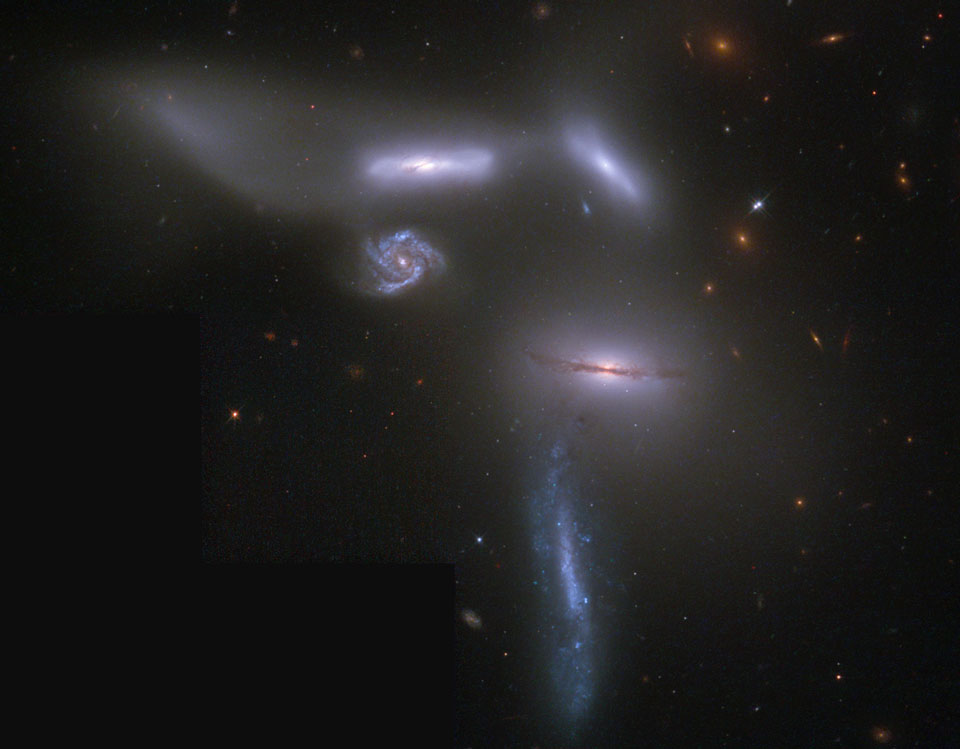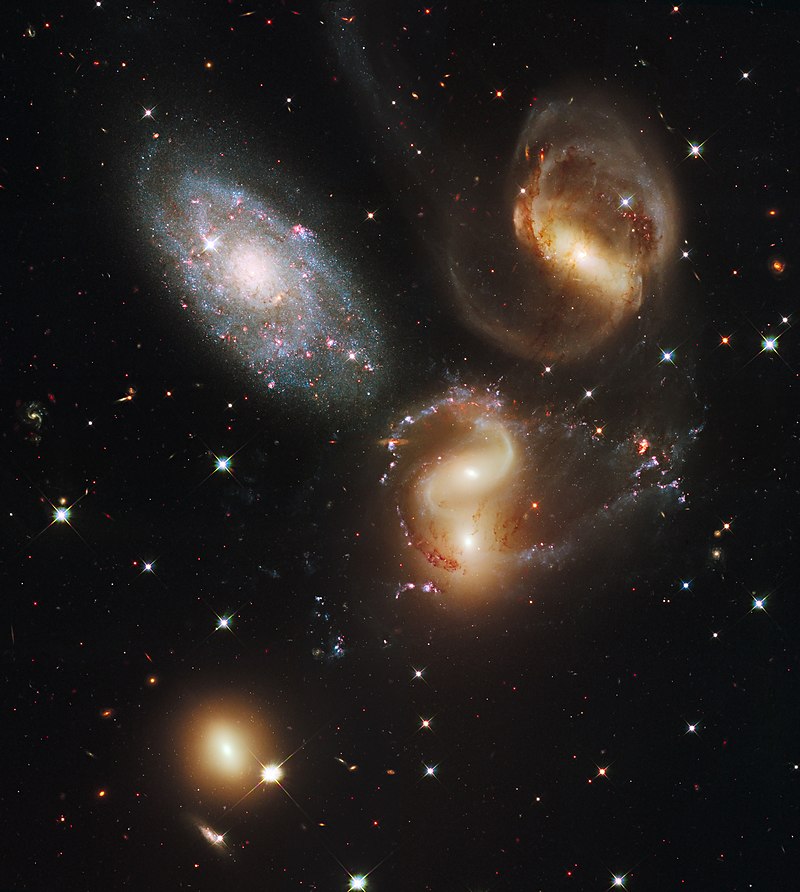Thanks, AVAO, I'm very glad you appreciate it!

And thanks for posting that closeup of the core of NGC 5566. That's amazing! Does it have two cores? Two supermassive black holes? I could find no information of that on the internet, but it sure looks like there are two hungry monsters at the center of NGC 5566!
You wrote:
But what really amazes me is that in so many galaxy families, the youngest child "shines in blue".
I don't think that the small blue galaxies are necessarily younger than the big yellow ones, but they have evolved quite differently.
I believe that the galaxies that later grew very big probably started out bigger than most other galaxies, even way back when galaxies first started forming. The ones that later grew so large probably formed from a slightly larger chunk of gas and dark matter than most other galaxies. Back in those days, the Universe was (comparatively) tiny and awash in gas, and those early galaxies must have slurped up huge helpings of gas that kept feeding their star formation.
According to
an astrobite from 2016, star formation peaked when the Universe was 3.5 billion years old, and its star formation has been winding down ever since. I'm pretty sure I have heard that the star formation of the Universe peaked even earlier, but you get my point: For a while there, hydrogen gas was there for the taking, and galaxies could just grab it and convert the gas into stars. Until too much of the gas had been locked up inside legions of stingy little red dwarf stars that are surprisingly massive for their puny appearance, and which hoard their (somewhat) meager share of gas until the end of time - or at least, until the Universe has doubled or tripled or quadrupled or... (you get it) - its present age!
So after a while galaxies generally stopped growing by simply acquiring free-floating gas from their vicinity. Instead, they started growing by merging with other galaxies, and by cannibalizing smaller galaxies. There was a great picture posted lately that demonstrated how it works:
In this interacting pair, the big galaxy is stealing stars and gas from the small galaxy. That is always how it works, isn't it? The big guy wins over the small guy?
As you can see in the Hubble image, the smaller component of Arp 282, IC 1559, looks bluish. So how blue is it really? Not too blue, it turns out. Its color is almost exactly the same as the color of dwarf galaxy Leo 1, which is seen very close to first magnitude blue star Regulus in the sky:
IC 1559 and Leo 1 have almost identical B-V indexes, which is a measure of how blue a galaxy is. For Leo 1, the B-V is +0.72, which means that its overall color is somewhere between "neutral" and "yellowish". Leo 1 is a dwarf galaxy completely devoid of young blue stars, but its stars are a little bluer than we would expect from their spectral classes due to the fact that they are extremely metal-poor.
Wikipedia wrote:
Typical to a dwarf galaxy, the metallicity of Leo I is very low, only one percent that of the Sun. Gallart et al. (1999) deduce from Hubble Space Telescope observations that the galaxy experienced a major increase (accounting for 70% to 80% of its population) in its star formation rate between 6 Ga and 2 Ga (billion years ago). There is no significant evidence of any stars that are more than 10 Ga old. About 1 Ga ago, star formation in Leo I appears to have dropped suddenly to an almost negligible rate, roughly coinciding with its latest periastron passage of the Milky Way. Ram pressure stripping would have removed its gas, decreasing its star formation rate.
So Leo 1 lost its gas when it passed close to the Milky Way, and then it stopped forming stars! But the stars it has got are very metal-poor, which makes their color bluer than it would otherwise have been. Do note that puny little Leo 1 has a central black hole of 3 million solar masses, almost as big as Sgr A*, the central black hole of our own big bully of a galaxy!

Anyway. The B-V index of Leo 1 is +0.72, whereas the B-V index of IC 1559 is +0.74! Their overall colors are almost identical! We can tell at a glance that IC 1559 can't be very blue, because it has very few clusters. And soon it will stop forming stars altogether, because NGC 169 is stealing gas from IC 1559, which powers its own star formation.
Why, then, do we see small blue galaxies in groups where the other galaxies are much yellower and bigger? My answer is that the small blue galaxies have only quite recently entered the group. They have not yet had their gas stolen from them by the big yellow bullies, but their gas has been "stirred" in a way that favors star formation.
Let's look at Stephan's Quintet:
Wikipedia wrote:
The brightest member of the visual grouping (
and the only non-member of the true group) is NGC 7320, which has extensive H II regions, identified as red blobs, where active star formation is occurring...
NGC 7320 indicates a small redshift (790 km/s) while the other four exhibit large redshifts (near 6,600 km/s). Since galactic redshift is proportional to distance, NGC 7320 is only a foreground projection and is ~39 million light-years from Earth, making it a possible member of the NGC 7331 group, versus the 210–340 million light-years of the other four.
So NGC 7320 is a possible member of the NGC 7331 group. Let's look at a picture of NGC 7320 together with NGC 7331:
NGC 7331 is at upper right in this ultraviolet image, whereas Stephan's Quintet with non-member NGC 7320 is a lower left. Note the perfect little oval of NGC 7320, evidence of the fact that the star formation here is not violent enough to disturb the overall shape of NGC 7320. It is however sufficiently close to NGC 7331 to have "felt its presence" and to have had its gas "stirred" so it was encouraged to start forming stars.
Also note the ultraviolet "wreckage" of the true members of Stephan's Quintet. The interaction of the members, as well as the actual collision between NGC 7318 A and NGC 7318 B, has thrown out enormous tendrils of gas where great numbers of huge young star clusters are being born.
Much of the gas that has been thrown out of the true members of Stephan's Quintet will fall back onto the galaxies again, but not all of it. And as the galaxies keep interacting and colliding, their gas will eventually either be "cast out" so far away that it won't fall back, or it will be swallowed by the central black holes that are undoubtedly building up inside these galaxies, or it will just generally become so turbulent as well as "thinned out" that it will no longer be able to form any new stars.
Why are large galaxies typically so yellow? That is because they have undergone burst after burst of star formation during their long history of mergers and cannibalizations of other galaxies. Each burst of star formation leaves behind very large numbers of small red and yellow stars. The bright blue stars that are formed in the same burst of star formation die quickly, but the long-lived red and yellow stars stay on and keep building up the large galaxies' hoard of small stars.
So, to summarize. Small blue galaxies are blue because they have quite recently started forming stars, and they have not undergone sufficient numbers of bursts of star formation to have built up huge numbers of long-lived red and yellow stars.
Many, and I'd say most, small galaxies are not forming stars. They are little yellow - make that pale yellow-white - conglomerates of old metal-poor stars, similar to dwarf galaxy Leo 1. But some small galaxies have received the "push" (or whatever) that they needed to start forming stars. Suddenly they start forming blue stars all over.
An example of such a galaxy is the Large Magellanic Cloud. According to a book of mine,
The Galaxies of the Local Group by Sidney van den Bergh, the LMC started forming a few clusters some 11.5 billion years ago. After that, the LMC remained almost completely "quiet" until 3 billion years ago, when it suddenly "exploded" in a burst of star formation that is still going on to this day. What happened?
The most probable answer, the way I understand it, is that the Large Magellanic Cloud came sufficiently close to the Small Magellanic Cloud some 3 billion years ago to have its gas "stirred" by the encounter. And because the LMC was always bigger than the SMC, and because the SMC was gas-rich, the LMC could start stealing stars and gas from its hapless companion and further fuel its own star formation.
So the most probable history of the Magellanic Clouds goes like this: 1) they start out as isolated galaxies with low levels of star formation, 2) they drift close enough to start interacting, which triggers star formation in both of them, 3) the LMC steals gas from the SMC, which keeps star formation at high levels in the LMC, while it starts winding down in the SMC, 4) the Magellanic Clouds are captured by the Milky Way and have started interacting with it, and 5) the LMC is going to collide with the Milky Way in 2.4 billion years' time (and will almost certainly drag the SMC with it, if the Magellanic clouds have not already merged by that time).
Wikipedia wrote:
The Milky Way and the LMC are predicted to merge in approximately 2.4 billion years.
Sci News wrote:
The Large Magellanic Cloud is the brightest satellite galaxy of the Milky Way and
only entered our neighborhood about 1.5 billion years ago.
Until recently astronomers thought that it would either orbit our Galaxy for many billions of years, or, since it moves so fast, escape from our Galaxy’s gravitational pull.
However, recent measurements indicate that the Large Magellanic Cloud has nearly twice as much dark matter than previously thought.
“Since it has a larger than expected mass, the Large Magellanic Cloud is rapidly losing energy and is doomed to collide with our Galaxy,” said Durham University astronomer Marius Cautun and co-authors...
“While two billion years is an extremely long time compared to a human lifetime, it is a very short time on cosmic timescales,” Dr. Cautun said.
“The destruction of the Large Magellanic Cloud, as it is devoured by the Milky Way, will wreak havoc with our Galaxy, waking up the black hole that lives at its center and turning our Galaxy into an active galactic nucleus or quasar.”
Well, scary! So what about M33, the bluest largish spiral galaxy of the Local Group? Is it a satellite of M31, the big bully of Andromeda, and will it collide with Andromeda in a few billion years time?
No, it turns out it won't.
Wouldn't you know that it is a recent visitor to the Local Group?
Universe Today wrote:
“The velocities we found show that M33 cannot be on a long orbit around M31,” says co-author Ekta Patel of the University of Arizona, USA. “Our models unanimously imply that
M33 must be on its first infall into M31.“
Yeah. Figures.
Anway, there you have it: A bright yellow galaxy has had a long and varied history with many "partners", whose many "kisses" have given it its bright yellow shine. A small blue galaxy has just met its first "partner". And a small pale yellow galaxy... well, it may have had a partner long ago, but now it can't remember.
Ann
 Arp 286: Trio in Virgo
Arp 286: Trio in Virgo






















